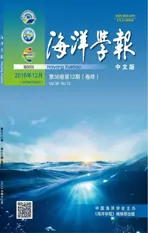北黄海獐子岛海域强壮箭虫(Sagitta crassa)丰度的周年变化及其与环境因子的关系
2016-12-21尹洁慧张光涛李超伦王世伟万艾勇
尹洁慧,张光涛,李超伦,王世伟,万艾勇
(1. 烟台大学 海洋学院,山东 烟台264005;2. 山东胶州湾海洋生态系统国家野外科学观测研究站,山东 青岛 266071;3. 中国科学院海洋研究所 海洋生态与环境科学重点实验室,山东 青岛 266071)
北黄海獐子岛海域强壮箭虫(Sagitta crassa)丰度的周年变化及其与环境因子的关系
尹洁慧1,张光涛2*,李超伦3,王世伟2,万艾勇2
(1. 烟台大学 海洋学院,山东 烟台264005;2. 山东胶州湾海洋生态系统国家野外科学观测研究站,山东 青岛 266071;3. 中国科学院海洋研究所 海洋生态与环境科学重点实验室,山东 青岛 266071)
强壮箭虫是我国温带海域的浮游动物优势种。本文通过2009年7月至2010年6月在北黄海獐子岛海域的逐月综合调查,研究了大网浮游动物中强壮箭虫丰度的周年变化及其与环境因子的关系。结果显示,强壮箭虫年平均丰度为22.6 ind/m3,高峰值出现在12月(47.5 ind/m3),最低值出现在8月(7.8 ind/m3);在水平分布上,除了夏季的8月,全年近岸海域强壮箭虫丰度均高于外海海域,且在10月及次年2月差异显著(P<0.05)。相关性分析显示,作为肉食性浮游动物,强壮箭虫丰度时空变化除了受温度和盐度影响外,还与饵料生物(主要是桡足类)丰度有关。我们认为,这是其丰度周年变化规律在不同海域出现明显差异的主要原因。
强壮箭虫;丰度;分布;环境因子;獐子岛
1 引言
强壮箭虫隶属于毛颚动物门箭虫纲[1],是一种暖温带的近岸优势种,在我国,强壮箭虫是黄海、渤海及近岸海域的常年优势种[2],个体较大,丰度较高,肉食性,主要以小型浮游动物为主,与高营养级的鱼类竞争摄食浮游动物[3],其捕食时速度很快,在海洋生态系统中起着十分重要的作用。
在国外对强壮箭虫的研究比较细化,主要涉及到其生活史特征[4—5],消化及产卵速率等[6—7],在我国有关强壮箭虫的研究主要有关于其摄食生态的研究[8—9],其对温度和盐度的耐受性研究[10],以及生活史状况的研究,在生态调查方面,有关于其在渤海[11—12]、黄海[13—17]、东海[18]、胶州湾[19]以及山东近岸沿海[20]的数量分布,季节变化的研究,但是关于强壮箭虫周年丰度变化及其平面分布的研究很少,本文主要针对在具有典型北黄海特征的獐子岛海域进行了强壮箭虫的周年平均丰度及平面分布调查,以便更好地了解强壮箭虫种群动态与环境因子之间的关系。
2 材料与方法
2.1 调查时间及站位布设
于2009年7月至2010年6月(除2010年1月和5月,由于天气原因未能登岛)搭乘“辽科渔19号”对獐子岛海域(38°45′~39°05′N,122°35′~122°55′E)进行了大面积调查(图1),在獐子岛及其邻近海域共布设了覆盖了3个断面的13个站位,其中以50 m等深线为基准,A1-A5、B1-B5、C1-C5站位属于近岸海域,A6、B6、C6站位处于非养殖区,且在黄海冷水团包围中。

图1 獐子岛海域2009-2010年航次采样站位分布Fig.1 Sample sites of cruises from 2009 to 2010 in waters around Zhangzi Island
2.2 样品采集及测定方法
样品采用标准大型浮游生物网(网口面积为0.5 m2,孔径为500 μm)进行从底到表的垂直拖网,获取的浮游动物用5%的甲醛溶液进行固定,样品在实验室内镜检计数。在采集浮游动物样品的同时,使用CTD(AAQ1183-1F)对环境中不同深度水层的温度、盐度等进行同步观测。
2.3 数据分析
将各站位大型浮游生物网采集样品作定量分析,根据采样时的滤水体积,以每立方米水体中的个体数(ind/m3)表示各种类的丰度(abundance)。
丰度与环境因子相关分析采用SPSS19.0中的Pearson相关性分析,采用Surfer9.0软件绘制站位图和等值线分布图。
3 结果
3.1 强壮箭虫丰度的周年变化情况
强壮箭虫是獐子岛海域的全年优势种,全年平均丰度22.60 ind/m3,它的高峰期主要在冬季的12月,平均丰度为47.5 ind/m3(图2),其余月份丰度较为平均,在7.82~29.2 ind/m3之间,从图中我们可以看出冬,春季2月及4月的丰度要高于夏秋季8-10月的丰度,其中全年夏季8月份丰度最低。

图2 獐子岛海域强壮箭虫丰度周年变化Fig.2 Annual variations of Sagitta crassa abundance in waters around Zhangzi Island
3.2 强壮箭虫丰度的周年平面分布情况
从调查海域的周年平面分布图(图3,图4)中可以看出除了夏季的8月,近岸的A1-A5、B1-B5、C1-C5站位数值要高于外海A6、B6、C6站位,我们进一步将近岸与外海站位强壮箭虫年平均丰度对比,发现近岸海域强壮箭虫除8月外,丰度在16.3~46.2 ind/m3之间,外海强壮箭虫年丰度在9.8~23.5 ind/m3之间,且在10月及次年的2月,近岸海域强壮箭虫平均丰度显著高于外海。
3.3 强壮箭虫丰度与环境因子的相关性
用SPSS19.0将强壮箭虫丰度与我们航次获得的环境因子数据进行相关性分析,我们发现,8月强壮箭虫丰度与表层温度呈显著负相关,10月及次年2月强壮箭虫丰度与表层及底层盐度呈显著负相关,4月强壮箭虫丰度与桡足类丰度成显著正相关(表1)。

表1 强壮箭虫丰度与环境因子的Spearman相关系数
注:其中样本数n=13 ,*表示在P<0.05 呈显著相关。

图3 獐子岛海域强壮箭虫2009年7月-2010年6月的平面分布Fig.3 The horizontal distribution of Sagitta crassa from July 2009 to June 2010 in waters around Zhangzi Island

图4 獐子岛近岸海域和外海强壮箭虫丰度2009-2010周年变化Fig.4 Annual variations of Sagitta crassa abundance at coastal and offshore areas from 2009 to 2010 in waters around Zhangzi Island

图5 獐子岛海域温度(A)、盐度(B)和桡足类丰度(C)周年变化情况Fig.5 Annual variations of temperature salinity and copepod abundance(A,B,C)in waters around Zhangzi Island
4 讨论
4.1 强壮箭虫周年丰度变化
獐子岛海域强壮箭虫丰度冬春季要高于夏秋季,这可能是受温度、盐度、桡足类丰度等多种因素共同影响的结果。
以往的研究结果显示强壮箭虫是一种近岸低盐种,其摄食强度在盐度20时最高,盐度25时次之[10];同时温度也是影响强壮箭虫分布的一个因素,研究表明强壮箭虫在冬季低水温时摄食强度最高[8],刘青等研究发现强壮箭虫摄食强度在水温10℃时最高,15℃次之,其最适摄食温度为10~15℃[10]。通过对獐子岛附近海域盐度的周年变化我们发现在夏季的7月和8月与冬季的12月表层平均盐度较低(图5),在温度方面,7月8月海水温度较高,其表层水温平均值在23℃左右,12月水温在6~7℃左右,综合盐度和温度的双重影响,冬季海水的盐度和温度更为适合强壮箭虫的生长,并且从相关性分析我们看到,8月表层温度与强壮箭虫丰度呈显著负相关(P<0.05),所以综合起来,强壮箭虫在冬季丰度最高,夏季丰度最低,夏季温度过高影响了其种群丰度。
在春季和秋季,獐子岛海域海水温度,盐度相当,但是在春季桡足类丰度却较高(图5),强壮箭虫为典型的肉食性浮游生物,主要摄食桡足类,且在4月,强壮箭虫丰度与桡足类丰度成显著正相关(P<0.05),所以在春季,桡足类丰度很可能是影响强壮箭虫种群数量的重要因素。
4.2 强壮箭虫的平面分布
强壮箭虫在獐子岛海域站位的周年平面分布图(图3)显示,除8月外,在近岸海域的A1-A5、B1-B5、C1-C5站位,强壮箭虫丰度要高于外海的A6、B6、C6站位。产生这种现象的原因很可能是强壮箭虫是一种近岸低盐种[10],而獐子岛近海海域的盐度较外海低(图6),在外海与近岸强壮箭虫丰度有显著差异的10月及次年的2月,盐度与强壮箭虫丰度呈显著负相关(P<0.05),说明盐度可能是造成两个区域强壮箭虫丰度分布差异的主要原因。
8月出现例外,很可能是因为7-8月黄海冷水团盛行,表底层水温温差在外海海域较为明显(图7),近岸海域所受影响较小,所以8月近岸海域的高温抑制了强壮箭虫的丰度,而在7月强壮箭虫丰度仍是近岸高于外海,可能是由于存在一个滞后效应。

图6 獐子岛海域7-12月表(A、 C、 E、G、I、K)、底(B、D、F、H、J、L)层盐度分布(黑点代表调查站位) Fig.6 Spatial variation of seawater salinity in surface (A,C,E,G,I,K) and bottom (B,D,F,H,J,L) layers in watersaround Zhangzi Island from July to December in 2009 (black dots showing the investigation sites)

图7 温度(℃)在獐子岛海域2009年7-12月A、B、C 断面的垂直分布Fig.7 Vertical distribution profiles of temperature(℃) along transects A、B and C from July to December in 2009 in waters around Zhangzi Island
4.3 与其他海域比较
獐子岛处于北黄海海域,强壮箭虫年度丰度范围在7.82~47.49 ind/m3,年平均丰度为22.6 ind/m3,与2006—2007年在北黄海大面站位的季度调查结果(春季24.9 ind/m3,夏季46.9 ind/m3,秋季101.6 ind/m3,冬季61.4 ind/m3)[13—14]比较,平均丰度值偏低;与胶州湾海域(6.9~70.6 ind/m3)[19]、山东近岸海域(63.2 ind/m3)[20]、黄河口海域(97.1~153.2 ind/m3)[21]、黄东海海域(夏季31.7 ind/m3,冬季48.3 ind/m3)[22]相比较而言,数值相对也较低;与东海和长江口海域(0.001~0.03 ind/m3)[18]相比较数值偏高,主要是强壮箭虫一直是黄海、渤海海域常年优势种,所以其数量偏高,而与整个北黄海和北方近岸海域相比较,数值偏低,可能是因为我们在北黄海獐子岛海域所设13个站位,平均水深较深,离岛特别近的站位只有3个,而强壮箭虫为一种近岸低盐种,这与站位的布设有很大关系。
[1] 萧贻昌. 中国动物志:无脊椎动物 第三十八卷 毛颚动物门箭虫纲[M]. 北京:科学出版社,1984:501-526.
Xiao Yichang. Fauna of China:Invertebrate Volume 38 Chaetognatha Sagittoidea[M]. Beijing:Science Press,1984:501-526.
[2] 中华人民共和国科学技术委员会海洋组海洋综合调查办公室. 全国海洋综合调查报告第八册[R]. 北京:中华人民共和国科学技术委员会海洋组海洋综合调查办公室,1964:48-51,113-117.
Comprehensive Marine Survey Office of Ocean Group Science and Technology Committee in People’s Republic of China. The national comprehensive Marine survey report Volume 8[R]. Beijing:Comprehensive Marine Survey Office of Ocean Group Science and Technology Committee in People’s Republic of China,1964:48-51,113-117.
[3] Mills C E. Medusae,siphonophores,and ctenophores as planktivorous predators in changing global ecosystems[J]. ICES Journal of Marine Science,1995,52(3/4):575-581.
[4] Murakami A. Marine biological study on the planktonic chaetognaths in the Seto Inland Sea[J]. Bulletin Naikai Regional Fishery Research Laboratory,1959,12:1-186.
[5] Nagasawa S. Vertical distribution,life cycle and production of the chaetognath Sagitta crassa in Tokyo Bay,Japan[J]. Journal of Plankton Research,1991,13(6):1325-1338.
[6] Nagasawa S. Laboratory feeding and egg production in the chaetognathSagittacrassaTokioka[J]. Journal of Experimental Marine Biology and Ecology,1984,76(1):51-65.
[7] Nagasawa S. The digestive efficiency of the chaetognathSagittacrassaTokioka,with observations on the feeding process[J]. Journal of Experimental Marine Biology and Ecology,1985,87(3):271-282.
[8] 杨纪明,李军. 渤海强壮箭虫摄食的初步研究[J]. 海洋科学,1995(6):38-42.
Yang Jiming,Li Jun. Study on the feeding of the Bohai SeaSagittacrassa[J]. Marine Sciences,1995(6):38-42.
[9] 刘青,曲晗,张硕,等. 强壮箭虫摄食生态的实验研究[J]. 水产学报,2006,30(6):767-772.
Liu Qing,Qu Han,Zhang Shuo,et al. Experimental study on the feeding ecology ofSagittacrassa[J]. Journal of Fisheries of China,2006,30(6):767-772.
[10] 刘青,曲晗,张硕. 强壮箭虫对温度、盐度的耐受性研究[J]. 海洋湖沼通报,2007(1):111-116.
Liu Qing,Qu Han,Zhang Shuo. Preliminary studies on the tolerance to temperature and salinity inSagittacrassa[J]. Transactions of Oceanology and Limnology,2007(1):111-116.
[11] 毕洪生,孙松,高尚武,等. 渤海浮游动物群落生态特点Ⅲ. 部分浮游动物数量分布和季节变动[J]. 生态学报,2001,21(4):513-521.
Bi Hongsheng,Sun Song,Gao Shangwu,et al. The characteristics of zooplankton community in the Bohai Sea Ⅲ. The distribution of abundance and seasonal dynamics of major taxa except copepoda[J]. Acta Ecologica Sinica,2001,21(4):513-521.
[12] 王克,张武昌,王荣,等. 渤海中南部春秋季浮游动物群落结构[J]. 海洋科学集刊,2002(44):34-42.
Wang Ke,Zhang Wuchang,Wang Rong,et al. The structure of zooplankton community in the central and southern part of the Bohai Sea,China,in Spring and Autumn[J]. Studia Marina Sinica,2002(44):34-42.
[13] 朱延忠. 夏、冬季北黄海大中型浮游动物群落生态学研究[D]. 青岛:中国海洋大学,2008.
Zhu Yanzhong. Study on the Macro-zooplankton and Meso-zooplankton Community Ecology in the Northern Yellow Sea in Summer and Winter[D]. Qingdao:Ocean University of China,2008.
[14] 姜强. 春、秋季北黄海大中型浮游动物群落生态学研究[D]. 青岛:中国海洋大学,2010.
Jiang Qiang. Study on the Macro-zooplankton and Mesozooplankton Community Ecology in the North Yellow Sea in Spring and Autumn[D]. Qingdao:Ocean University of China. 2010.
[15] 戴玉燕. 南黄海和东海毛颚类生态特征的研究 Ⅰ. 数量分布的特征[J]. 海洋学报,2006,28(6):106-111.
Dai Yuyan. Study on the ecological characteristics of Chaetognatha in waters ofSouthernHuanghaiSeaandEastChinaSeaⅠ. The characteristics of quantitative distribution[J]. Haiyang Xuebao,2006,28(6):106-111.
[16] 戴玉燕,林茂. 南黄海和东海毛颚类生态特征的研究 Ⅱ. 群落特征[J]. 海洋学报,2007,29(3):90-97.
Dai Yuyan,Lin Mao. Study on the ecological characteristics of Chaetognatha in waters of Southern Huanghai Sea and East China Sea Ⅱ. Community characteristics[J]. Haiyang Xuebao,2007,29(3):90-97.
[17] 左涛,王荣,王克,等. 夏季南黄海浮游动物的垂直分布与昼夜垂直移动[J]. 生态学报,2004,24(3):524-530.
Zuo Tao,Wang Rong,Wang Ke,et al. Vertical distribution and diurnal migration of zooplankton in the Southern Yellow Sea in summer[J]. Acta Ecologica Sinica,2004,24(3):524-530.
[18] 李云,徐兆礼,高倩. 长江口强壮箭虫和肥胖箭虫的丰度变化对环境变暖的响应[J]. 生态学报,2009,29(9):4773-4780.
Li Yun,Xu Zhaoli,Gao Qian. Effects of global warming onSagittacrassaandSagittaenflata(Chaetognatha) in the Changjiang Estuary during different years[J]. Acta Ecologica Sinica,2009,29(9):4773-4780.
[19] 王倩,孙松,霍元子,等. 胶州湾毛颚类生态学研究[J]. 海洋与湖沼,2010,41(4):639-644.
Wang Qian,Sun Song,Huo Yuanzi,et al. The ecology of chaetognaths in Jiaozhou Bay[J]. Oceanologia et Limnologia Sinica,2010,41(4):639-644.
[20] 徐风风,朱丽岩,徐潇峰,等. 山东半岛黄海沿岸强壮箭虫丰度的季节变化和分布特征[J]. 中国海洋大学学报,2014,44(5):54-60.
Xu Fengfeng,Zhu Liyan,Xu Xiaofeng,et al. Seasonal variation and distribution characteristics ofSagittacrassain Yellow Sea coast of the Shandong Peninsula[J]. Periodical of Ocean University of China,2014,44(5):54-60.
[21] 马静. 夏、秋季黄河口及其邻近海域大中型浮游动物群落生态学研究[D]. 青岛:中国海洋大学,2011.
Ma Jing. Studies on the meso-and macro-zooplankton community ecology in the Yellow River estuary and its adjacent waters in summer and autumn[D]. Qingdao:Ocean University of China,2011.
[22] 齐衍萍. 夏、冬季黄东海浮游动物群落生态学研究[D]. 青岛:中国海洋大学,2008
Qi Yanping. Study on the Community Ecology of Zooplankton in the Yellow Sea and the East China Sea in Summer and Winter[D]. Qingdao:Ocean University of China,2008.
Annual variation in abundance of Saggita crassa and its relationship with environment conditions around the Zhangzi Island,Northern Yellow Sea
Yin Jiehui1,Zhang Guangtao2,Li Chaolun3,Wang Shiwei2,Wan Aiyong2
(1.OceanCollege,YantaiUniversity,Yantai264005,China; 2.JiaozhouBayEcosystemResearchStation,Qingdao266071,China; 3.KeyLaboratoryofMarineEcologyandEnvironmentalSciences,InstituteofOceanology,ChineseAcademyofSciences,Qingdao266071,China)
Saggitacrassais one of the most important dominant zooplankton species in temperate China seas. Based on samples collected during monthly investigation (July 2009 to June 2010) around the Zhanagzi Island,we demonstrated annual variation of abundance and its correlation with environmental conditions. In our study,its abundance averaged in 22.6 ind/m3on annual cycle,with monthly maximum in December (47.5 ind/m3) and minimum (7.8 ind/m3) in August. Spatially,the abundance was higher at stations near the island comparing to those in open waters in all months but August. The difference was statistically significant in October and February (P<0.05). As a carnivore,temporal and spatial distribution ofS.crassawas influenced by not only water temperature and salinity but also that of prey populations (mainly copepods). Thus,we propose that different annual patterns ofS.crassaover various geographical regions were impacted by that of prey communities.
Saggitacrassa; abundance;distribution;environment factors;Zhangzi Island
2016-04-16;
2016-09-13。
国家自然科学青年基金(41506153);中科院海洋所海洋生态与环境科学实验室开放基金项目。
尹洁慧(1986—),女,内蒙古自治区呼伦贝尔市人,博士,主要从事海洋浮游动物研究。E-mail:yinjiehui@sohu.com
*通信作者:张光涛,研究员,主要从事海洋浮游动物研究。E-mail:gtzhang@qdio.ac.cn
10.3969/j.issn.0253-4193.2016.12.009
Q958.8
A
0253-4193(2016)12-0086-09
尹洁慧,张光涛,李超伦,等. 北黄海獐子岛海域强壮箭虫(Sagittacrassa)丰度的周年变化及其与环境因子的关系[J].海洋学报,2016,38(12):86—94,
Yin Jiehui,Zhang Guangtao,Li Chaolun,et al. Annual variation in abundance ofSaggitacrassaand its relationship with environment conditions around the Zhangzi Island,Northern Yellow Sea[J]. Haiyang Xuebao,2016,38(12):86—94,doi:10.3969/j.issn.0253-4193.2016.12.009
